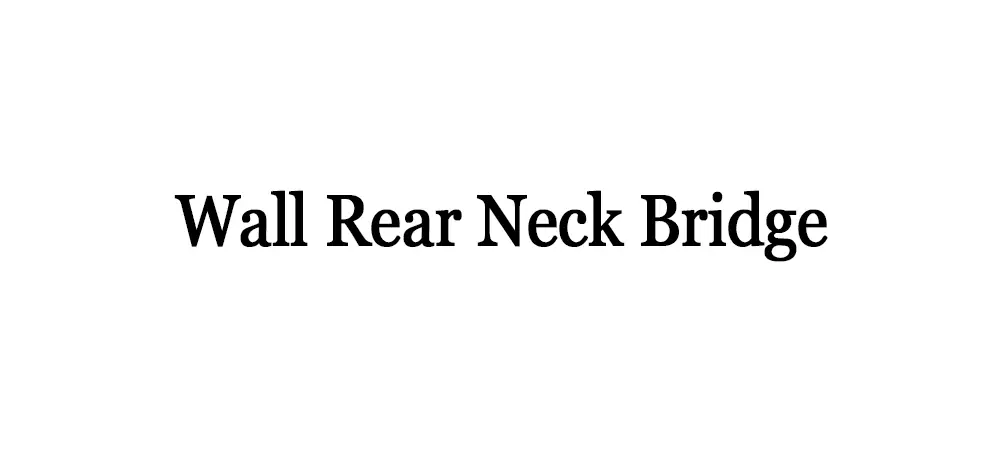Table of Contents
Introduction for Wall Rear Neck Bridge
Introducing the Wall Rear Neck Bridge, a powerful exercise aimed at fortifying the muscles surrounding the neck and enhancing cervical spine stability. In a world dominated by sedentary lifestyles and prolonged screen time, neck discomfort and tension have become increasingly common issues. The Wall Rear Neck Bridge offers a practical solution to address these concerns, providing a targeted approach to strengthening and supporting the delicate structures of the neck.
In this guide, we’ll delve into the mechanics, benefits, and proper execution of the Wall Rear Neck Bridge, empowering you to incorporate this exercise effectively into your fitness regimen. Whether you’re striving to alleviate neck pain, improve posture, or enhance athletic performance, the Wall Rear Neck Bridge stands as a versatile tool to promote neck health and resilience. Join us as we explore the transformative potential of this simple yet impactful exercise.
Instructions for Wall Rear Neck Bridge
Here’s how to perform the Wall Rear Neck Bridge with proper technique:
- Setup:
- Stand facing away from a wall, with your feet hip-width apart and your back towards the wall.
- Stand at a distance from the wall where you can comfortably lean back and place the back of your head against the wall.
- Head Placement:
- Gently lean back, allowing the back of your head to make contact with the wall. Your head should be in a neutral position, with your chin slightly tucked.
- Hand Placement:
- Place your hands on your hips or by your sides for stability. Ensure that your arms are relaxed throughout the exercise.
- Bridge Position:
- While maintaining contact between the back of your head and the wall, slowly lean your body backward, allowing your upper back to come into contact with the wall.
- Engage your core muscles to stabilize your spine and pelvis as you lean back. Your body should form a straight line from your head to your hips.
- Hold and Contract:
- Hold the bridge position for 10-30 seconds, focusing on contracting the muscles at the back of your neck and upper back.
- Imagine pressing the back of your head into the wall to further engage the muscles of the neck and upper back.
- Return to Starting Position:
- Slowly return to the starting position by gently pressing your head and upper back into the wall, using your core muscles to control the movement.
- Maintain control and avoid arching your lower back excessively as you return to the starting position.
- Repeat:
- Perform 5-10 repetitions of the Wall Rear Neck Bridge, gradually increasing the duration of each hold as your strength and comfort level improve.
Tips for Proper Form:
- Keep your chin slightly tucked throughout the exercise to maintain a neutral spine alignment.
- Avoid straining or overextending your neck and back during the movement. Focus on controlled, smooth motions.
- Engage your core muscles throughout the exercise to stabilize your spine and pelvis.
Safety Considerations:
- Start with a conservative range of motion and gradually increase the intensity as your neck strength improves.
- If you experience any discomfort or pain in your neck or back during the exercise, stop immediately and consult with a healthcare professional.
- Ensure that the wall is clean and free from any sharp objects or rough surfaces that could cause injury to the skin or head.
Incorporate the Wall Rear Neck Bridge into your routine to strengthen the muscles of the neck and upper back, improve cervical spine stability, and promote better posture. Focus on maintaining proper form and technique throughout the exercise for optimal safety and effectiveness.
Benefits
The Wall Rear Neck Bridge offers numerous benefits for strengthening the muscles surrounding the neck and promoting cervical spine stability. Here are some key advantages of incorporating this exercise into your routine:
- Neck Strength: By engaging the muscles at the back of the neck, including the suboccipital muscles and deep cervical flexors, the Wall Rear Neck Bridge helps strengthen these important muscles, promoting greater neck stability and resilience.
- Posture Improvement: Strong neck muscles play a crucial role in maintaining proper posture. The Wall Rear Neck Bridge targets the muscles responsible for supporting the head and neck, helping to counteract the effects of poor posture and promoting a more upright spinal alignment.
- Neck Pain Relief: Strengthening the muscles surrounding the neck can help alleviate tension and discomfort commonly associated with neck pain. The Wall Rear Neck Bridge provides targeted strengthening of these muscles, potentially reducing the frequency and severity of neck pain episodes.
- Prevention of Neck Injuries: A strong and stable neck is less prone to injuries such as strains, sprains, and whiplash. By strengthening the muscles of the neck and improving cervical spine stability, the Wall Rear Neck Bridge can help reduce the risk of these injuries during daily activities or athletic endeavors.
- Enhanced Athletic Performance: Athletes and fitness enthusiasts can benefit from the increased neck strength and stability gained through the Wall Rear Neck Bridge. A stronger neck can improve performance in sports and activities that involve rapid changes in direction, impact, and head movement.
- Improved Neck Mobility: While primarily a strengthening exercise, the Wall Rear Neck Bridge also encourages gentle stretching of the neck muscles, promoting greater flexibility and range of motion. Improved neck mobility can enhance overall comfort and movement quality.
- Mind-Body Connection: Performing the Wall Rear Neck Bridge requires focus and concentration to maintain proper form and alignment. This exercise encourages mindfulness and awareness of the neck muscles, promoting a stronger mind-body connection and greater body awareness.
Incorporating the Wall Rear Neck Bridge into your routine can contribute to better overall neck health, improved posture, and reduced risk of neck pain and injuries. As with any exercise, it’s essential to perform the Wall Rear Neck Bridge with proper form and technique to maximize its benefits and minimize the risk of strain or injury.
Muscles worked in Wall Rear Neck Bridge
The Wall Rear Neck Bridge primarily targets the muscles located at the back of the neck and the upper back. Here are the key muscles worked during this exercise:
- Suboccipital Muscles: These small muscles are located at the base of the skull and play a crucial role in head and neck movement control. The Wall Rear Neck Bridge engages the suboccipital muscles to stabilize the head and neck during the exercise.
- Trapezius Muscle: The upper portion of the trapezius muscle, known as the upper traps, extends from the base of the skull to the middle of the back. This muscle helps elevate and retract the shoulder blades and assists in neck extension and lateral flexion.
- Levator Scapulae: This muscle runs along the side and back of the neck, connecting the upper cervical vertebrae to the shoulder blade (scapula). It helps elevate the shoulder blade and tilt the head to the side.
- Rhomboid Muscles: The rhomboids are located between the shoulder blades and help retract the scapulae (shoulder blades). They play a crucial role in maintaining proper shoulder blade alignment and stability.
- Posterior Neck Muscles (Erector Spinae Group): While not directly targeted by the exercise, the muscles along the back of the neck, including the splenius capitis and splenius cervicis, assist in stabilizing and supporting the neck during the Wall Rear Neck Bridge.
By engaging these muscles, the Wall Rear Neck Bridge strengthens the posterior chain of the neck and upper back, promoting greater stability, posture, and resistance to injury. Regular practice of this exercise can contribute to improved neck strength, reduced neck pain, and enhanced overall neck health.
Video
Alternate names of Wall Rear Neck Bridge
Alternate names for the Wall Rear Neck Bridge include:
- Wall Neck Extension
- Wall Neck Bridge
- Wall Head Bridge
- Wall Head Extension
- Wall Neck Retraction
- Wall Neck Strengthening Exercise
- Wall Neck Stability Drill
- Wall Posterior Neck Bridge
- Wall Neck Isometric Hold
- Wall Neck Endurance Exercise
These alternate names may vary depending on context or personal preference but generally describe the same exercise targeting the muscles at the back of the neck and upper back.
FAQs
Here are some frequently asked questions (FAQs) about the Wall Rear Neck Bridge exercise:
What is the Wall Rear Neck Bridge?
The Wall Rear Neck Bridge is an exercise designed to strengthen the muscles at the back of the neck and upper back. It involves leaning against a wall with the head and upper back, then pushing gently against the wall to engage these muscles.
How do I perform the Wall Rear Neck Bridge?
Start by standing with your back against a wall, feet shoulder-width apart. Lean back until your head and upper back are touching the wall. Engage the muscles at the back of your neck and upper back by gently pushing your head and upper back into the wall. Hold for a few seconds, then release.
What muscles does the Wall Rear Neck Bridge work?
The Wall Rear Neck Bridge primarily targets the muscles at the back of the neck, including the suboccipital muscles, trapezius, levator scapulae, and rhomboids. These muscles help support the head and neck and maintain proper posture.
What are the benefits of the Wall Rear Neck Bridge?
The Wall Rear Neck Bridge can help strengthen the muscles of the neck and upper back, improve posture, reduce neck pain and tension, and enhance cervical spine stability. It can also help prevent neck injuries and improve athletic performance.
How often should I do the Wall Rear Neck Bridge?
You can perform the Wall Rear Neck Bridge 2-3 times per week, as part of a comprehensive strength training routine. Start with a few repetitions and gradually increase as your strength and comfort level improve.
Is the Wall Rear Neck Bridge safe for everyone?
While the Wall Rear Neck Bridge is generally safe for most people, it’s essential to use proper form and technique to avoid strain or injury. If you have any pre-existing neck or back conditions, or if you experience pain or discomfort during the exercise, consult with a healthcare professional before continuing.
Can I modify the Wall Rear Neck Bridge?
Yes, you can modify the Wall Rear Neck Bridge by adjusting the intensity or range of motion based on your fitness level and comfort. You can also use props such as a towel or cushion for added support.
How long should I hold the Wall Rear Neck Bridge?
Aim to hold the Wall Rear Neck Bridge for 10-30 seconds, focusing on engaging the muscles at the back of the neck and upper back. Gradually increase the duration as you become more comfortable with the exercise.
Performing the Wall Rear Neck Bridge regularly can help improve neck strength, posture, and overall neck health. As with any exercise, listen to your body and stop if you experience any pain or discomfort.
Conclusion
In conclusion, the Wall Rear Neck Bridge is a valuable exercise for strengthening the muscles at the back of the neck and upper back, improving posture, and enhancing cervical spine stability. By leaning against a wall and gently pushing the head and upper back into the wall, this exercise effectively targets key muscles involved in supporting the head and neck.
Incorporating the Wall Rear Neck Bridge into your routine can provide numerous benefits, including reduced neck pain and tension, improved posture, and enhanced resistance to neck injuries. Whether you’re seeking relief from neck discomfort or looking to enhance your overall neck strength and stability, the Wall Rear Neck Bridge offers a practical and effective solution.
Remember to perform the exercise with proper form and technique, gradually increasing the intensity and duration as your strength improves. Listen to your body, and if you experience any pain or discomfort, consult with a healthcare professional before continuing.
Make the Wall Rear Neck Bridge a regular part of your strength training routine to enjoy the benefits of a stronger, more resilient neck and upper back. With consistency and dedication, you can achieve better neck health and overall well-being.
An alternate exercise for the Wall Rear Neck Bridge is the Prone Cobra. Here’s how to perform it:
- Start Position: Lie face down on a mat or the floor with your arms by your sides and your forehead resting on the ground.
- Hand Placement: Place your hands on the floor, palms facing down, slightly wider than shoulder-width apart.
- Engage Core: Engage your core muscles to stabilize your spine and pelvis.
- Lift Chest and Arms: Inhale as you lift your chest and arms off the ground, keeping your gaze towards the floor to maintain a neutral neck position.
- Squeeze Shoulder Blades: As you lift, squeeze your shoulder blades together to engage the muscles of the upper back.
- Hold and Contract: Hold the lifted position for 10-30 seconds, focusing on contracting the muscles of the upper back and neck.
- Lower Down: Exhale as you lower your chest and arms back to the starting position.
- Repeat: Perform 5-10 repetitions of the Prone Cobra, gradually increasing the duration of each hold as your strength and comfort level improve.
The Prone Cobra targets similar muscles as the Wall Rear Neck Bridge, including the muscles of the upper back and neck, while also engaging the muscles of the shoulders and core. It’s a great alternative exercise that can be performed without any equipment and helps promote neck and upper back strength and stability.








